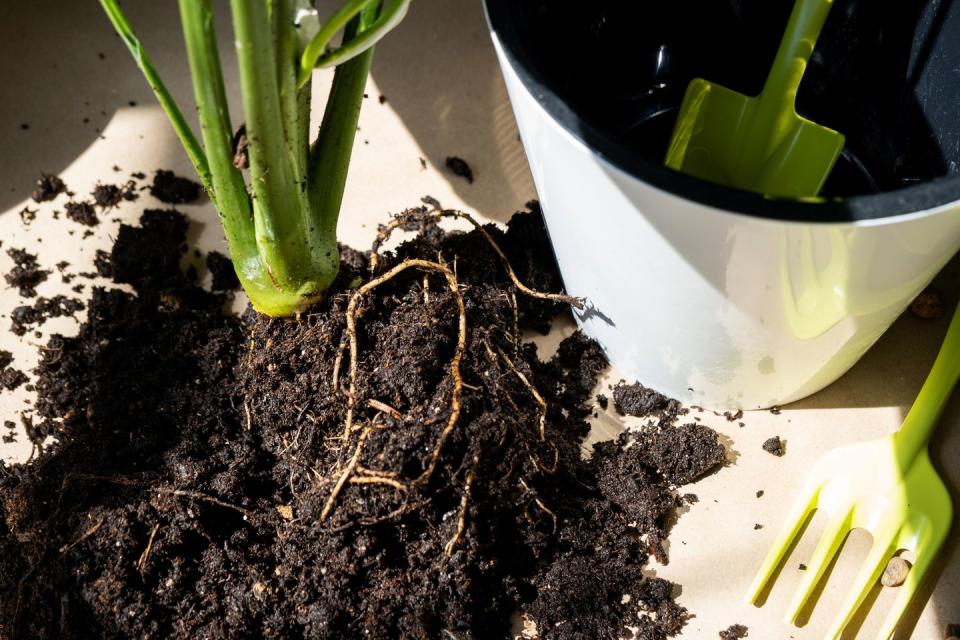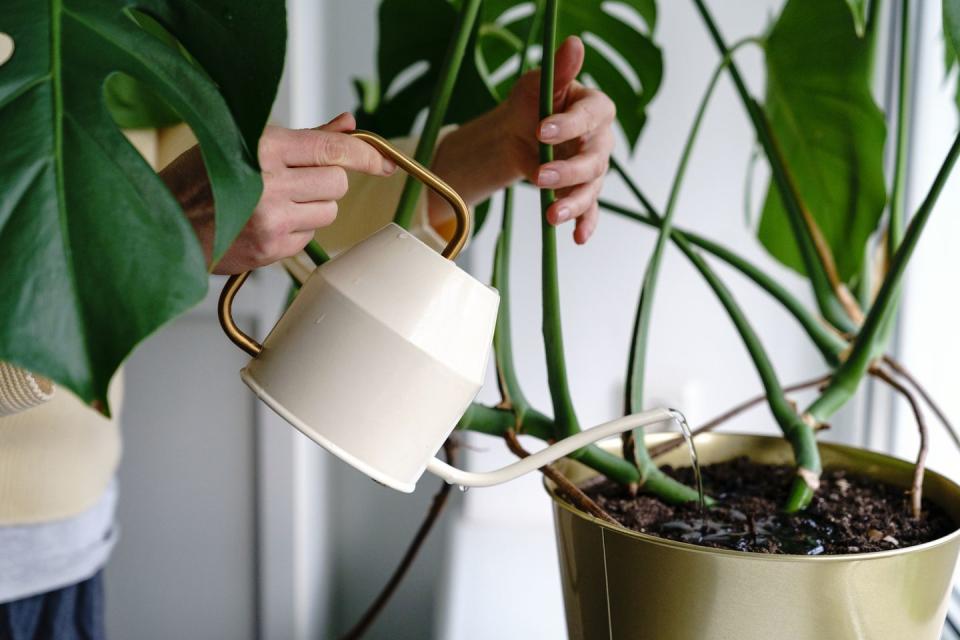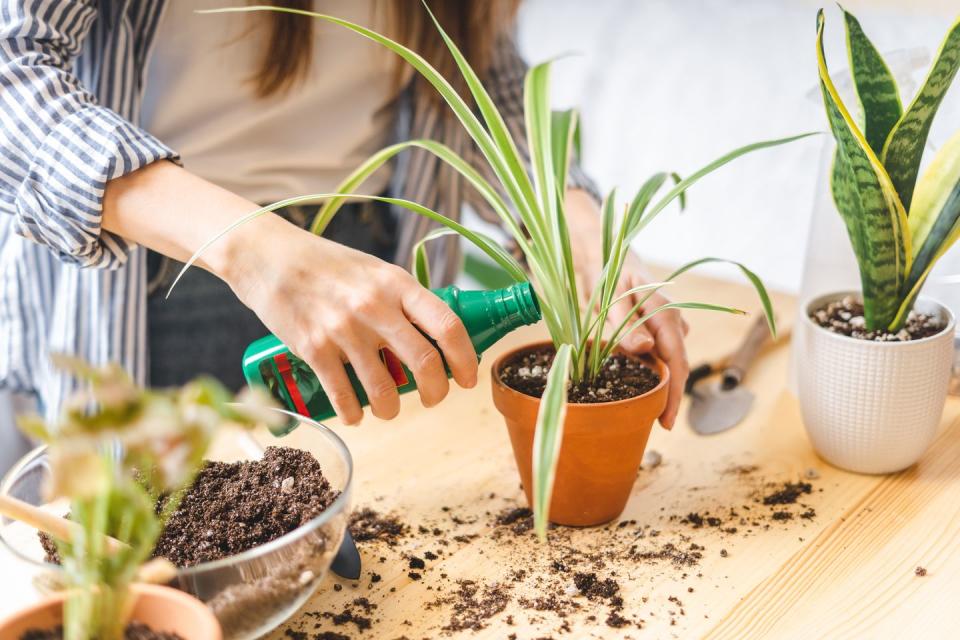Your 9-step guide to happy & healthy houseplants this spring
- 1/10
Your 9-step guide to happy & healthy houseplants this spring
The arrival of spring often sees houseplants beginning to come out of their dormant period, so there's no better time to give them some TLC and get your potted friends ready for the warmer months ahead. As your indoor plants begin to actively grow again, you're one goal is to keep them healthy and happy so that, in turn, they produce plenty of new leaves. But how, exactly? From repotting and positioning to watering and fertilising, here are nine ways to get your houseplants ready for spring.
Delmaine Donson - Getty Images - 2/10
1) Cut off any dead leaves
Using a clean, sharp pair of scissors or pruners, cut off any dead leaves which appear brown or yellow, or which show early signs of disease.
'Some plant species are particularly susceptible to diseases such as leaf spot, black leg, or sooty mould, so making sure your scissors are sterile is important,' say the experts at houseplant food brand Baby Bio.
Iryna Imago - Getty Images - 3/10
2) Trim plants back
As well as dead leaves, you may have noticed that some stems look weaker than others, which is expected following the tougher conditions of winter. All you have to do is trim back any long stems with just a few leaves. Your plant may look a little sparse for now, but springtime is when it will be focusing all of its energy on growing new shoots, stems and leaves.
Olga Yakovleva - Getty Images - 4/10
3) Give the leaves a clean
If your houseplants have gathered a layer of dust on their leaves, now is the ideal time to give them a clean to ensure they are ready to soak up the sun this spring.
Using a damp cloth and tepid water, gently wipe away any dust while supporting the leaf with your hand to prevent any damage. If you have a plant with large, rubbery leaves – such as a monstera or fig leaf – this ritual is especially important.
Westend61 / Getty Images - 5/10
4) Check the roots
There are several ways to tell if your plant needs repotting:
- If it needs watering more often than usual
- If you notice the roots are growing out of its drainage holes
- If you gently ease your plant from its pot and the roots look tight or tangled around the root ball.
These are all potential signs that your plant needs more space to grow.
Bogdan Kurylo - Getty Images - 6/10
5) Repotting
'To repot, begin by adding a couple of inches of a well-draining compost, which promotes aeration to the roots and allows good drainage, to a pot approximately one to two inches wider in circumference than its existing home,' the experts explain.
To remove your plant from its current pot, tip the container to the side and gently tease the plant and its roots free. Remove any compost mix that has gathered around the root ball.
Then add some potting mix to the new container and fill until the plant sits level with the top of the container and fill the gaps around the side if necessary.
eclipse_images - Getty Images - 7/10
6) What to do about early signs of root rot
If you find that a plant’s roots are soft and brown, this could indicate early signs of root rot, which can happen when roots are left in waterlogged compost.
But don’t despair. The plant can be saved by trimming off any dead or dying roots, right back to where the root is firm and white again.
Ольга Симонова / Getty Images - 8/10
7) Check to see if you need to increase your watering schedule
As the weather starts to get warmer, this typically means that your indoor plants will require more watering. You'll want to test the soil first by inserting your finger or a pencil into the top two inches. As a general rule, if it's still moist, there's no need to water.
'If the soil is dry beyond the top layer, aerate the soil to allow for an even distribution of water,' the experts advise. 'To ensure you’re not giving your houseplants too much, water from the bottom if your pot has drainage holes.'
Dmitry Marchenko / EyeEm / Getty Images - 9/10
8) When to use fertiliser
Spring is the perfect time to start using a fertiliser to make sure your plants get all the nutrients that they need, from stronger roots to brighter blooms and more luscious leaves.
'As a general rule of thumb, most plants need a mix of nitrogen, phosphorous and potassium for optimum growth, so invest in a plant food which can provide the perfect balance,' the experts explain.
While an all-purpose feed will usually do the job, some specialist plants, like cacti or bonsai trees, do require slightly different nutrients, so it's worth double checking exactly what your plant needs first.
Anna Ostanina / EyeEm / Getty Images - 10/10
9) Move your plants to a sunny spot
Finally, you'll want to move your plants to a sunny spot so that they can soak up that springtime sunshine. Placing them near east-facing windows is best but wherever you place your plant, ensure the leaves don't get scorched by direct sunlight.
You can also increase humidity levels by placing your plants next to a tray of pebbles in a shallow layer of water. And don’t forget to mist them regularly, too.
Catherine Falls Commercial / Getty Images

 Yahoo Finance
Yahoo Finance 




















